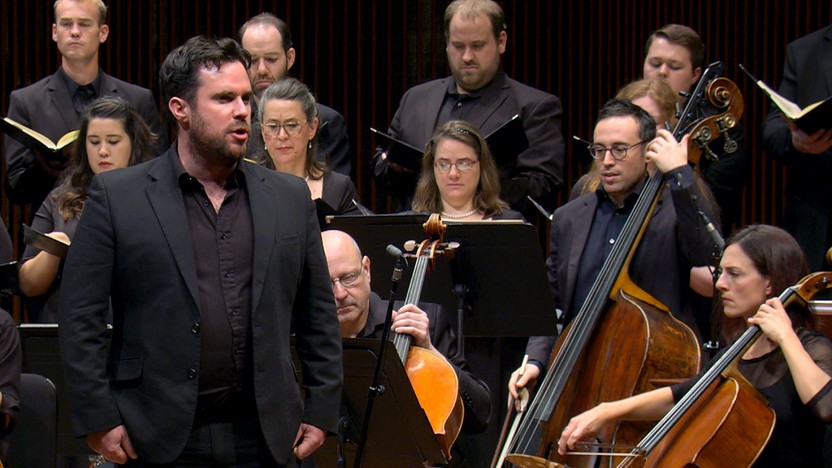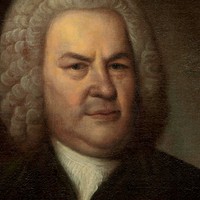Bach’s Saint John Passion



From 1723 until his death in 1750, Bach held the demanding position of Thomaskantor, directing music for the principal churches of Leipzig and training the young choristers at the church school. In his early years he wrote new cantatas for weekly services at an astounding pace, and he took special care with music for the all-important Vespers service on Good Friday, which always featured a rendition of the Passion—the account of Jesus’s last days, from his arrival in Jerusalem to his crucifixion, as recounted in the Gospels of Matthew, Mark, Luke and John.
Not many years earlier, the congregation would simply recite the Passion liturgy in an unadorned, plainchant style. The idea of presenting the Passion as a dramatic oratorio only took hold around 1712, when the poet Barthold Brockes published a libretto that was soon set to music by Telemann and Handel among other early adopters. It caught on first in more progressive cities like Hamburg and Frankfurt, and within a few years even conservative Leipzig warmed to the idea.
Bach probably attempted some sort of Passion setting earlier in Weimar, but the work that stands as his first great achievement in the new style was the St. John Passion from 1724, offered during his first yearlong cantata cycle for Leipzig. He was probably hoping to follow the next year with a setting of the Gospel of Matthew, but that even larger composition did not appear until 1727; the Good Friday service in 1725 instead featured a revised version of the St. John Passion, including some music that was later redirected to the St. Matthew Passion. Bach brought the St. John Passion back several more times, making musical adjustments along the way, until he directed the work for the last time in 1749.
The St. John Passion is smaller in scale than its sibling work, and it has not enjoyed quite the celebrated status that the St. Matthew Passion has had ever since Felix Mendelssohn resuscitated that work (and Bach’s reputation in general) with a landmark performance in 1829. But the intimacy of the St. John Passion is finally getting its due, thanks to decades of scholarship and historically-informed performance practice that have stripped back oversized choruses and orchestras, coming closer to the sound and spirit of the lean ensembles Bach would have squeezed into the tiny choir lofts of Leipzig’s churches.
An ornate chorus, “Herr, unser Herrscher” (Lord, Thou our Master), begins the first part of the Passion. With the recitative that follows, we meet the Evangelist, a tenor soloist who narrates the story with lines drawn verbatim from Martin Luther’s German translation of the Bible. The drama pauses for points of reflection in the form of solo arias, with texts assembled by an unknown librettist. Other key anchor points are the familiar Lutheran chorales that Bach’s congregation would have known well, including the hymns that bookend the break between Part I and Part II, marking the point in the service when the sermon would be delivered.
In the second part, Jesus appears before Pontius Pilate, with the chorus standing in at times for the inflamed crowd. Again arias magnify the richest emotions, with support from obbligato counter-lines assigned to various solo instruments. The chorus that precedes the final hymn, beginning with the invitation to “Rest well,” underscores the sweet and humble essence of the St. John Passion.
Aaron Grad ©2018

From 1723 until his death in 1750, Bach held the demanding position of Thomaskantor, directing music for the principal churches of Leipzig and training the young choristers at the church school. In his early years he wrote new cantatas for weekly services at an astounding pace, and he took special care with music for the all-important Vespers service on Good Friday, which always featured a rendition of the Passion—the account of Jesus’s last days, from his arrival in Jerusalem to his crucifixion, as recounted in the Gospels of Matthew, Mark, Luke and John.
Not many years earlier, the congregation would simply recite the Passion liturgy in an unadorned, plainchant style. The idea of presenting the Passion as a dramatic oratorio only took hold around 1712, when the poet Barthold Brockes published a libretto that was soon set to music by Telemann and Handel among other early adopters. It caught on first in more progressive cities like Hamburg and Frankfurt, and within a few years even conservative Leipzig warmed to the idea.
Bach probably attempted some sort of Passion setting earlier in Weimar, but the work that stands as his first great achievement in the new style was the St. John Passion from 1724, offered during his first yearlong cantata cycle for Leipzig. He was probably hoping to follow the next year with a setting of the Gospel of Matthew, but that even larger composition did not appear until 1727; the Good Friday service in 1725 instead featured a revised version of the St. John Passion, including some music that was later redirected to the St. Matthew Passion. Bach brought the St. John Passion back several more times, making musical adjustments along the way, until he directed the work for the last time in 1749.
The St. John Passion is smaller in scale than its sibling work, and it has not enjoyed quite the celebrated status that the St. Matthew Passion has had ever since Felix Mendelssohn resuscitated that work (and Bach’s reputation in general) with a landmark performance in 1829. But the intimacy of the St. John Passion is finally getting its due, thanks to decades of scholarship and historically-informed performance practice that have stripped back oversized choruses and orchestras, coming closer to the sound and spirit of the lean ensembles Bach would have squeezed into the tiny choir lofts of Leipzig’s churches.
An ornate chorus, “Herr, unser Herrscher” (Lord, Thou our Master), begins the first part of the Passion. With the recitative that follows, we meet the Evangelist, a tenor soloist who narrates the story with lines drawn verbatim from Martin Luther’s German translation of the Bible. The drama pauses for points of reflection in the form of solo arias, with texts assembled by an unknown librettist. Other key anchor points are the familiar Lutheran chorales that Bach’s congregation would have known well, including the hymns that bookend the break between Part I and Part II, marking the point in the service when the sermon would be delivered.
In the second part, Jesus appears before Pontius Pilate, with the chorus standing in at times for the inflamed crowd. Again arias magnify the richest emotions, with support from obbligato counter-lines assigned to various solo instruments. The chorus that precedes the final hymn, beginning with the invitation to “Rest well,” underscores the sweet and humble essence of the St. John Passion.
Aaron Grad ©2018
We extend our warmest thanks to the following donors whose special financial support has made these performances and video capture of Bach’s Saint John Passion possible.
Cathedral Heritage Foundation and Curators
Annette Conklin and Anita Pampusch
Greg DeWitt
Connie Foote
Judith Garcia Galiana and Alberto Castillo
Lowell and Cay Shea Hellervik
Betty Indihar
Paul and Barbara Klaas
Robert L. Lee and Mary Schaffner
Alfred P. and Ann M. Moore
James and Carolyn Nestingen
Otto Bremer Trust
John Riehle and Margaret Lindlof
Get driving directions and find nearby parking.
Find dining options close to the venue.
View seating charts to find out where you'll be seating.
Get driving directions and find nearby parking.
Find dining options close to the venue.
View seating charts to find out where you'll be seating.
